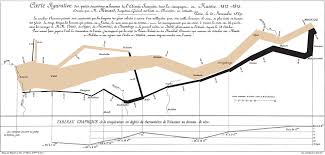Good Reads meta-data is 213 pages rated 4.15 by 2,354 litizens.
Genre: Methodology.
DNA: Data.
Verdict: Close the barn door.
Tagline: Down with Power Point.
Edward Tufte has authored many excellent and creative books on presenting and analysing data, becoming a one-man industry. He made famous Charles Minard’s (1869) graphic of Le Grand armée of Napoleon’s invasion of Russia. Tufte nominates this image as one of the very best visual displays of information. Many readers will have seen a version of it even if the names Minard and Tufts are unknown.

Power Point (PP), launched in 1990, was in its adolescence when Tufte wrote this chapter, but now PP is a fully grown adult with ubiquitous grandchildren. Its lineage has become so dominant that its cognitive stye has been assimilated by most of us without being conscious of what it is. In fact most who have been indoctrinated into PP do not even know it.
Tufte’s master narrative is that PP, like all cultural artefacts, reflects the social structure of the environment in which it was created, and it promotes these structures in its diffusion. (He doesn’t say it quite this way, but I gave it a Mary Douglas spin with some Michel Foucault seasoning. It was generated in a giant corporation called Microsoft, and it mirrors the features of such a large rent-seeking organisation in being hierarchical, linear, simple, and bureaucratic. Its first purpose was to be a tool for salesmen to sell advertising campaigns to other large corporations marketing products, it is well to remember, and it still bears that birthmark.
The convergence of these characteristics produces superficiality. Tufte demonstrates this shallowness repeatedly. The simplest example of the many he presents is this: four sheets of A4 paper can hold enough information (words or data) to fill 200 PP slides.
An audience can read the text or data on a PP screen three times faster than a presenter reading it out loud, but many presenters still insist on doing that. It is something we have all endured, a nervous presenter who makes a joke about PP overkill and then proceeds to do that with forty-five slides in a 10-minute presentation. The audience was lost right after the joke. At best, Tufte allows, PP is a useful crutch for the poorest 10% of presenter such as the preceding example. For the rest it is a hinderance.
Let it be clear, the Cognitive Style is inherent in PP, not brought to it by the presenter. However it is now true that the cognitive style of Power Point has permeated the culture and practice of presentations and one hardly dares not use it – either the style or the application or both – for fear of being beyond the pale. It has become the norm. We audience members have been primed to expect it as the lingua franca of presentations at seminars, lectures, workshops, conferences, hearings, and everywhere. Indeed many innocents have never seen a presentation that wasn’t PPed, even if PP itself wasn’t used, its style was. Like a virus the cognitive style has been contagious and has infected other hosts. What is this style?

It forces a presenter to shun comparisons since they cannot be shown. To presume the reality is linear even when it may be reflexive. And it resolves things to the dozen words that go on even a text heavy slide in a font that can be read by the audience.
What is the alternative? In some cases PP should not be used at all, indeed, front of the room presentation should not be used. For engineering, conventional written reports are far superior, and they should be read not presented, and then discussed. In the main Tufte recommends a very serviceable alternative: sentences. Discussion in short.
If it is put on the screen, the audience reads it and does not attend to what is said. Sight beats sound more often than not, for example music videos use sights to distract from the ostensible music.
Moreover, the slides endure, posted on web sites, distributed by email, printed on paper. What is said about each slide evaporates into the air.
I know I have railed about PP in 2021, but here I am at it again.
P.S. Christie’s Auction House has on offer this title in a set of three of his other titles for $US 8,000. Do your Christmas shopping early!

